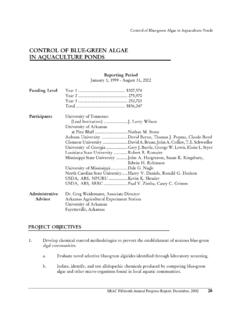Transcription of 11 Microbial fact sheets - WHO
1 221 fact sheets are provided on potential waterborne pathogens as well as on indicatorand index potential waterborne pathogens include: bacteria, viruses, protozoa and helminths identified in Table and Figure ,with the exception ofSchistosoma, which is primarily spread by contact with contaminated surface water during bathing and washing; potentially emerging pathogens, including Helicobacter pylori,Tsukamurella,Isospora belliand microsporidia, for which waterborne transmission is plausi-ble but unconfirmed; Bacillus, which includes the foodborne pathogenic species Bacillus cereusbut forwhich there is no evidence at this time of waterborne transmission; and hazardous human health effects caused by waterborne transmission vary in severity frommild gastroenteritis to severe and sometimes fatal diarrhoea, dysentery, hepatitis andtyphoid fever.
2 Contaminated water can be the source of large outbreaks of disease,including cholera, dysentery and cryptosporidiosis; for the majority of waterbornepathogens, however, there are other important sources of infection, such as person-to-person contact and waterborne pathogens are introduced into drinking-water supplies in humanor animal faeces, do not grow in water and initiate infection in the gastrointestinaltract following ingestion. However,Legionella, atypical mycobacteria,Burkholderiapseudomalleiand Naegleria fowleriare environmental organisms that can grow inwater and soil.
3 Besides ingestion, other routes of transmission can include inhalation,leading to infections of the respiratory tract ( ,Legionella, atypical mycobacteria),and contact, leading to infections at sites as diverse as the skin and brain ( ,Naegleria fowleri,Burkholderia pseudomallei).Of all the waterborne pathogens, the helminth Dracunculus medinensisis unique in that it is the only pathogen that is solely transmitted through fact sheetsGUIDELINES FOR DRINKING-WATER QUALITY222 The fact sheets on potential pathogens include information on human healtheffects, sources and occurrence, routes of transmission and the significance of drink-ing-water as a source of infection.
4 The fact sheets on microorganisms that can be usedas indicators of the effectiveness of control measures or as indices for the potentialpresence of pathogenic microorganisms provide information on indicator value,source and occurrence, application and significance of Bacterial pathogensMost bacterial pathogens potentially transmitted by water infect the gastrointestinaltract and are excreted in the faeces of infected humans and other animals. However,there are also some waterborne bacterial pathogens, such as Legionella,Burkholderiapseudomalleiand atypical mycobacteria, that can grow in water and soil.
5 The routesof transmission of these bacteria include inhalation and contact (bathing), with infec-tions occurring in the respiratory tract, in skin lesions or in the AcinetobacterGeneral descriptionAcinetobacter spp. are Gram-negative, oxidase-negative, non-motile coccobacilli(short plump rods). Owing to difficulties in naming individual species and biovars,the term Acinetobacter calcoaceticus baumannii complex is used in some classificationschemes to cover all subgroups of this species, such as A. baumannii,A. iwoffii and health effectsAcinetobacterspp. are usually commensal organisms, but they occasionally causeinfections, predominantly in susceptible patients in hospitals.
6 They are opportunisticpathogens that may cause urinary tract infections, pneumonia, bacteraemia, second-ary meningitis and wound infections. These diseases are predisposed by factors such as malignancy, burns, major surgery and weakened immune systems, such as inneonates and elderly individuals. The emergence and rapid spread of multidrug-resistant A. calcoaceticus baumannii complex, causing nosocomial infections, are ofconcern in health care and occurrenceAcinetobacter spp. are ubiquitous inhabitants of soil, water and sewage has been isolated from 97% of natural surface water samples in numbersof up to 100/ml.
7 The organisms have been found to represent of the HPCflora in drinking-water samples and have been isolated from 5 92% of distributionwater samples. In a survey of untreated groundwater supplies in the USA,Acineto-bacterspp. were detected in 38% of the groundwater supplies at an arithmetic meandensity of 8/100 ml. The study also revealed that slime production, a virulence factorfor A. calcoaceticus, was not significantly different between well water isolates and 11. Microbial fact SHEETS223clinical strains, suggesting some degree of pathogenic potential for strains isolatedfrom spp.
8 Are part of the natural Microbial flora of theskin and occasionally the respiratory tract of healthy of exposureEnvironmental sources within hospitals and person-to-person transmission are thelikely sources for most outbreaks of hospital infections. Infection is most commonlyassociated with contact with wounds and burns or inhalation by susceptible individ-uals. In patients with Acinetobacterbacteraemia, intravenous catheters have also beenidentified as a source of infection. Outbreaks of infection have been associated withwater baths and room humidifiers. Ingestion is not a usual source of in drinking-waterWhile Acinetobacterspp.
9 Are often detected in treated drinking-water supplies, an asso-ciation between the presence ofAcinetobacterspp. in drinking-water and clinicaldisease has not been confirmed. There is no evidence of gastrointestinal infectionthrough ingestion ofAcinetobacterspp. in drinking-water among the general popula-tion. However, transmission of non-gastrointestinal infections by drinking-water maybe possible in susceptible individuals, particularly in settings such as health care facil-ities and hospitals. As discussed in chapter 6, specific WSPs should be developed forbuildings, including hospitals and other health care facilities.
10 These plans need to take account of particular sensitivities of spp. are sensitive to disinfectants such as chlorine, and numbers will be low in the presence of a dis-infectant residual. Control measures that can limit growth of the bacteria in distri-bution systems include treatment to optimize organic carbon removal, restriction of the residence time of water in distribution systems and maintenance of dis-infectant spp. are detected by HPC, which can be used together with parameters such as disinfectant residuals to indicate conditions thatcould support growth of these organisms.










